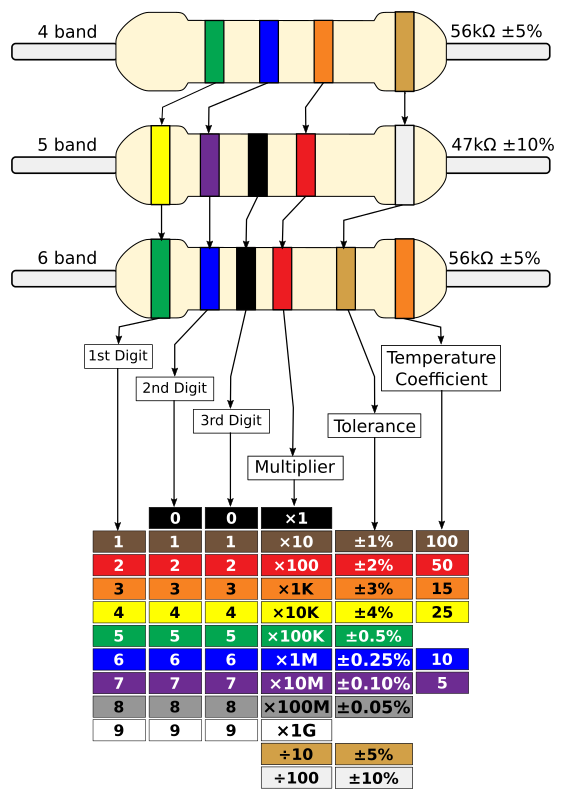3: Resistors
- Page ID
- 432887
\( \newcommand{\vecs}[1]{\overset { \scriptstyle \rightharpoonup} {\mathbf{#1}} } \)
\( \newcommand{\vecd}[1]{\overset{-\!-\!\rightharpoonup}{\vphantom{a}\smash {#1}}} \)
\( \newcommand{\id}{\mathrm{id}}\) \( \newcommand{\Span}{\mathrm{span}}\)
( \newcommand{\kernel}{\mathrm{null}\,}\) \( \newcommand{\range}{\mathrm{range}\,}\)
\( \newcommand{\RealPart}{\mathrm{Re}}\) \( \newcommand{\ImaginaryPart}{\mathrm{Im}}\)
\( \newcommand{\Argument}{\mathrm{Arg}}\) \( \newcommand{\norm}[1]{\| #1 \|}\)
\( \newcommand{\inner}[2]{\langle #1, #2 \rangle}\)
\( \newcommand{\Span}{\mathrm{span}}\)
\( \newcommand{\id}{\mathrm{id}}\)
\( \newcommand{\Span}{\mathrm{span}}\)
\( \newcommand{\kernel}{\mathrm{null}\,}\)
\( \newcommand{\range}{\mathrm{range}\,}\)
\( \newcommand{\RealPart}{\mathrm{Re}}\)
\( \newcommand{\ImaginaryPart}{\mathrm{Im}}\)
\( \newcommand{\Argument}{\mathrm{Arg}}\)
\( \newcommand{\norm}[1]{\| #1 \|}\)
\( \newcommand{\inner}[2]{\langle #1, #2 \rangle}\)
\( \newcommand{\Span}{\mathrm{span}}\) \( \newcommand{\AA}{\unicode[.8,0]{x212B}}\)
\( \newcommand{\vectorA}[1]{\vec{#1}} % arrow\)
\( \newcommand{\vectorAt}[1]{\vec{\text{#1}}} % arrow\)
\( \newcommand{\vectorB}[1]{\overset { \scriptstyle \rightharpoonup} {\mathbf{#1}} } \)
\( \newcommand{\vectorC}[1]{\textbf{#1}} \)
\( \newcommand{\vectorD}[1]{\overrightarrow{#1}} \)
\( \newcommand{\vectorDt}[1]{\overrightarrow{\text{#1}}} \)
\( \newcommand{\vectE}[1]{\overset{-\!-\!\rightharpoonup}{\vphantom{a}\smash{\mathbf {#1}}}} \)
\( \newcommand{\vecs}[1]{\overset { \scriptstyle \rightharpoonup} {\mathbf{#1}} } \)
\( \newcommand{\vecd}[1]{\overset{-\!-\!\rightharpoonup}{\vphantom{a}\smash {#1}}} \)
\(\newcommand{\avec}{\mathbf a}\) \(\newcommand{\bvec}{\mathbf b}\) \(\newcommand{\cvec}{\mathbf c}\) \(\newcommand{\dvec}{\mathbf d}\) \(\newcommand{\dtil}{\widetilde{\mathbf d}}\) \(\newcommand{\evec}{\mathbf e}\) \(\newcommand{\fvec}{\mathbf f}\) \(\newcommand{\nvec}{\mathbf n}\) \(\newcommand{\pvec}{\mathbf p}\) \(\newcommand{\qvec}{\mathbf q}\) \(\newcommand{\svec}{\mathbf s}\) \(\newcommand{\tvec}{\mathbf t}\) \(\newcommand{\uvec}{\mathbf u}\) \(\newcommand{\vvec}{\mathbf v}\) \(\newcommand{\wvec}{\mathbf w}\) \(\newcommand{\xvec}{\mathbf x}\) \(\newcommand{\yvec}{\mathbf y}\) \(\newcommand{\zvec}{\mathbf z}\) \(\newcommand{\rvec}{\mathbf r}\) \(\newcommand{\mvec}{\mathbf m}\) \(\newcommand{\zerovec}{\mathbf 0}\) \(\newcommand{\onevec}{\mathbf 1}\) \(\newcommand{\real}{\mathbb R}\) \(\newcommand{\twovec}[2]{\left[\begin{array}{r}#1 \\ #2 \end{array}\right]}\) \(\newcommand{\ctwovec}[2]{\left[\begin{array}{c}#1 \\ #2 \end{array}\right]}\) \(\newcommand{\threevec}[3]{\left[\begin{array}{r}#1 \\ #2 \\ #3 \end{array}\right]}\) \(\newcommand{\cthreevec}[3]{\left[\begin{array}{c}#1 \\ #2 \\ #3 \end{array}\right]}\) \(\newcommand{\fourvec}[4]{\left[\begin{array}{r}#1 \\ #2 \\ #3 \\ #4 \end{array}\right]}\) \(\newcommand{\cfourvec}[4]{\left[\begin{array}{c}#1 \\ #2 \\ #3 \\ #4 \end{array}\right]}\) \(\newcommand{\fivevec}[5]{\left[\begin{array}{r}#1 \\ #2 \\ #3 \\ #4 \\ #5 \\ \end{array}\right]}\) \(\newcommand{\cfivevec}[5]{\left[\begin{array}{c}#1 \\ #2 \\ #3 \\ #4 \\ #5 \\ \end{array}\right]}\) \(\newcommand{\mattwo}[4]{\left[\begin{array}{rr}#1 \amp #2 \\ #3 \amp #4 \\ \end{array}\right]}\) \(\newcommand{\laspan}[1]{\text{Span}\{#1\}}\) \(\newcommand{\bcal}{\cal B}\) \(\newcommand{\ccal}{\cal C}\) \(\newcommand{\scal}{\cal S}\) \(\newcommand{\wcal}{\cal W}\) \(\newcommand{\ecal}{\cal E}\) \(\newcommand{\coords}[2]{\left\{#1\right\}_{#2}}\) \(\newcommand{\gray}[1]{\color{gray}{#1}}\) \(\newcommand{\lgray}[1]{\color{lightgray}{#1}}\) \(\newcommand{\rank}{\operatorname{rank}}\) \(\newcommand{\row}{\text{Row}}\) \(\newcommand{\col}{\text{Col}}\) \(\renewcommand{\row}{\text{Row}}\) \(\newcommand{\nul}{\text{Nul}}\) \(\newcommand{\var}{\text{Var}}\) \(\newcommand{\corr}{\text{corr}}\) \(\newcommand{\len}[1]{\left|#1\right|}\) \(\newcommand{\bbar}{\overline{\bvec}}\) \(\newcommand{\bhat}{\widehat{\bvec}}\) \(\newcommand{\bperp}{\bvec^\perp}\) \(\newcommand{\xhat}{\widehat{\xvec}}\) \(\newcommand{\vhat}{\widehat{\vvec}}\) \(\newcommand{\uhat}{\widehat{\uvec}}\) \(\newcommand{\what}{\widehat{\wvec}}\) \(\newcommand{\Sighat}{\widehat{\Sigma}}\) \(\newcommand{\lt}{<}\) \(\newcommand{\gt}{>}\) \(\newcommand{\amp}{&}\) \(\definecolor{fillinmathshade}{gray}{0.9}\)Introduction
- Function as a load
- convert electric energy to heat
- P = IV = rate of energy consumption
- Used in resistance heaters
- Used to control current
- Do Not Overload!
 Figure \(\PageIndex{1}\): Common resistors. (David Ludovino, CC 3.0, Wikimedia commons)
Figure \(\PageIndex{1}\): Common resistors. (David Ludovino, CC 3.0, Wikimedia commons)What happens when to much current passes through a resistor?
Video \(\PageIndex{1}\): 2:48 min YouTube by Tariq Lab showing what happens if you send too much current through a resistor by hooking it up to too high a voltage (https://youtu.be/M_3QyLOW9Zs?si=-BaxqiSfD2sqqH6u)
Resistor Values
Use bands to describe resistors. There are four types of bands
- Digits
- Multiplier
- Tolerance
- Temperature Coefficient
 Figure \(\PageIndex{2}\): Resistor Color Chart (4,5 & 6 band). (Koudstall; Open clipart, CC 1.0 )
Figure \(\PageIndex{2}\): Resistor Color Chart (4,5 & 6 band). (Koudstall; Open clipart, CC 1.0 )
Variable Resistors
There are two basic types of variable resistors, Rheostats and Potentiometers. Rheostats control current and potentiometers can control voltage or current.
 Figure \(\PageIndex{3}\): Circuit diagram symbols for Rheostat and Potentiometer. (Belford, CC 0.0)
Figure \(\PageIndex{3}\): Circuit diagram symbols for Rheostat and Potentiometer. (Belford, CC 0.0)
Video \(\PageIndex{2}\): 1:18 min YouTube by Calco Tech Tips on the Difference Between Potentiometers and Rheostats (https://youtu.be/qCvnN2F_bRg?si=XnMty1XqjMr2cIxL)
Rheostat
A Rheostat has two terminals and is used to regulate current and can be used for high current applications.
Video \(\PageIndex{3}\): 4:35 min YouTube by DERF Electronics on How a Rheostat works - Step by Step & its different applications (https://www.youtube.com/watch?v=isA5I9JFjA4), This video comes from their tutorial on An Overview on Rheostats.
Potentiometer
A potentiometer has three terminals can be used to regulate either current or voltage, but is not designed for high current flows. Potentiometers are often integrated into circuit boards. They are effectively adjustable voltage dividers
 Figure \(\PageIndex{4}\): Copy and Paste Caption here. (Copyright; author via source)
Figure \(\PageIndex{4}\): Copy and Paste Caption here. (Copyright; author via source)Here the potentiostat can be used to trigger an alarm if a gas concentration reaches a set concentration by adjusting the voltage at which a digital signal is sent.
Video \(\PageIndex{4}\) 1:54 min YouTube on Potentiometers by Mouser Electronics (https://youtu.be/oZbSvG7rUAA?si=-t8esOuFKY9okIbv).
The circuit on the left is a voltage divider and on the right is a potentiostat (variable voltage divider). If you hoover over the power supply you will see it is 10 V, and when the simulation loads both circuits have 10K on either side of the divider. Now if you move the resistance on the left side with the slider in the panel, you can see how the potentiometer can alter the current at the divider


